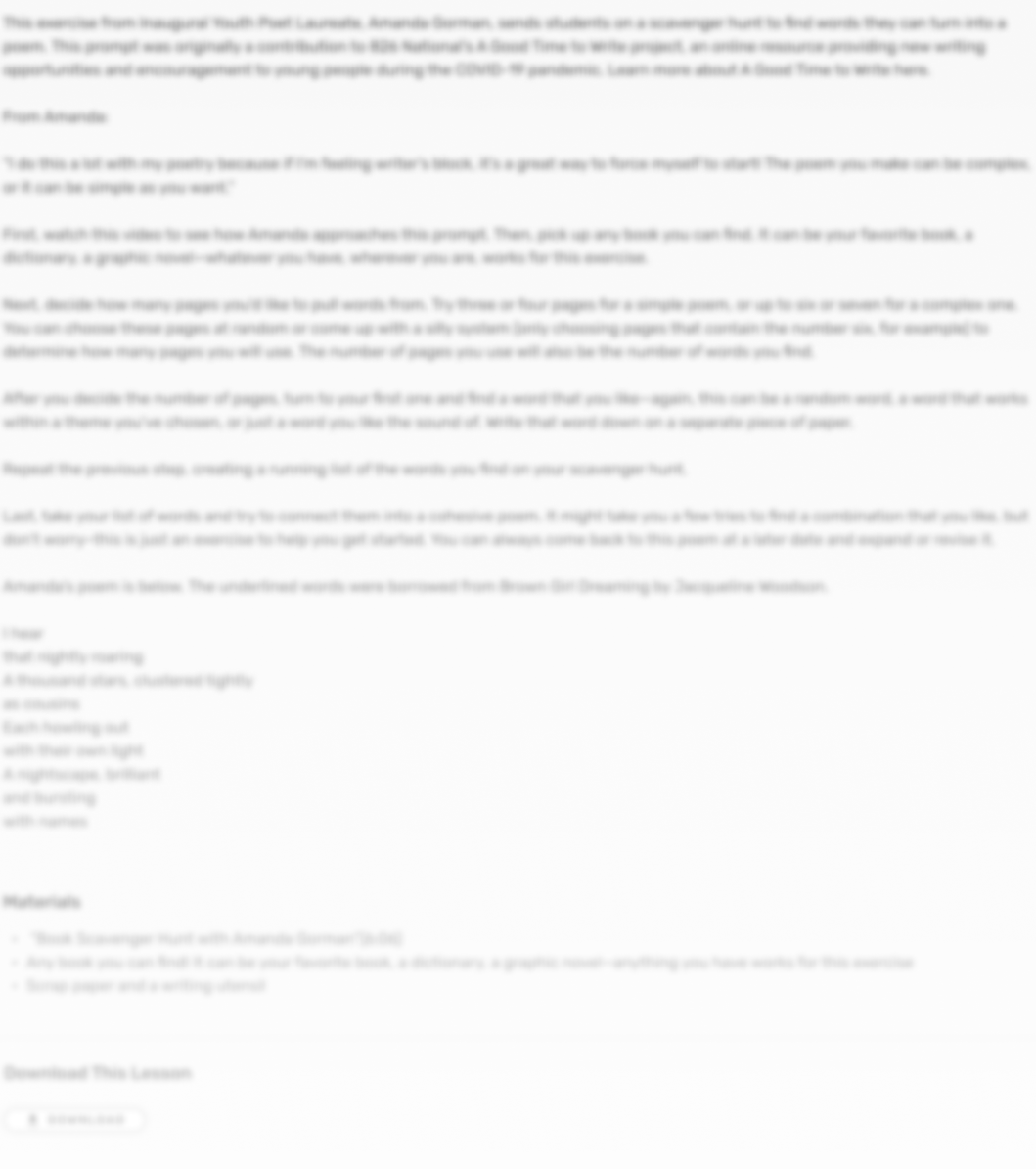 Grades 4–6
Grades 4–6 60 minutes
60 minutes Media, Narrative
Media, Narrative Videos
VideosSean Thomason has written for late night television, children’s animated television, and numerous internet companies and apps. His primary job has been writing and producing for RiffTrax, a comedy company that grew out of the cult classic show Mystery Science Theater 3000. RiffTrax creates a range of content, from online episodes to television specials to annual live shows. At RiffTrax, Thomason writes jokes, sketch comedy, website copy, and email promotions.
You will learn how to use dialogue and narration in a scene to show the reader a character’s traits.



STEP 1
Watch the video and then answer this question in your writing journal: What is the funniest thing you’ve heard someone say recently? Why did you think it was funny?
STEP 2
Next, you will create 2 very general characters to write dialogue for. On page 1 of the Silly Scenes — Handout, there is a group of traits and a group of jobs to choose from. Follow the directions on page 1 to complete this activity.
STEP 3
Read the example scene on page 2 of the handout. After you read the scene, answer the reflection question at the bottom of the page: What do you notice about the way this scene is written? What are the 2 main ways the reader learns that the Chef is forgetful and the Doctor is angry?
STEP 4
The 2 main ways the reader...

by Emily Harding
Author and TV producer, Emily Harding shows side characters some love in this writing prompt.
by 826 National, featuring Isaac Reynolds, Grade 6
What’s the moral of the story? In this lesson, students practice identifying and summarizing a moral in a fable written by a sixth grader.
by 826 National, featuring Iman Abdullah, Grade 2, 826NYC
Have you ever thought about what you have in common with an animal? In this lesson, students will write a comparison poem that explores these similarities and differences.
by Mychal Threets, librarian and literacy ambassador
Librarian and literacy ambassador Mychal Threets invites you to write about your feelings, your way with four writing prompts to explore your emotions on the page.
by 826 National
In this lesson, you will build your confidence as a writer by battling the page on a consistent basis.
by Amanda Dettmann, 826NYC
Poet and teaching artist with 826NYC, Amanda Dettmann, shares a simple and fun writing prompt that asks the question, "How Did You Get There?"
by 826 National, featuring Milo Wu, Grade 2, NY
In this lesson, you will introduce an animal you know a lot about as the narrator of a story. The narrator will provide descriptive details ask the reader "Guess who?" at the end.
by Kinyel Friday, 826michigan
Children's book author, and 826michigan staff member, Kinyel Friday shares a social emotional learning prompt that uses personification to bring emotions to life.
by 826 National
Author Tom Perrotta reads "Peter, Who Went on the Best Adventure Ever." In this lesson, you will learn about 3 shapes that will help the events of your story unfold naturally.
by Amanda Gorman
Presidential Inaugural Poet, activist, and bestselling author Amanda Gorman shares one of her favorite techniques for starting a poem or getting over writers' block.
by 826 National
Misinformation Specialist with Google Nidhi Hebbar shares how you can use writing to inspire change and bring people into conversations about the issues you care about.
by Javier Zamora, 826 Valenica alumni and New York Times bestselling author
Author Javier Zamora invites you to raise your voice and write to the next President of the United States.
by Molly Sprayregen, 826CHI
Writer and 826michigan staffer Denise Ervin writes alongside students to show what feelings sound like.
by 826 National
Novelist and short story writer, Caitlin Horrocks, reads "My Full Yard" by Marisol of 826michigan and reflects on the imagery used in the poem.
by 826 National
Author Carter Higgins reads "Pickup Lines Cheesier Than Cheddar," a piece written by fifth-grader Uma (826NYC).
by 826 National, featuring Nayeli Karunasekara, grade 6, Michigan
Through reading a Mentor Text, students learn more about the types of point of view and how different points of view impact their writing.
by 826 National, featuring Kaiden Griggs, Grade 6
In this lesson, students will identify the main idea and supporting details of an informational text and summarize this idea objectively.
by Sarah Richman, 826DC
Writer and staffer at 826DC, Sarah Richman, shares an original writing prompt that will help you get aquainted with your new characters.
by Cristeta Boarini, 826 MSP
Journalist and 826 MSP staffer, Cristeta Boarini, shares a poetry prompt that walks students through using shapes to convey meaning.
by 826 National
In this lesson, you will create a simple scrapbook that showcases the facts, definitions, and details you’ve learned about a few of the items you found in a scavenger hunt.
by Daniel Handler
Author Daniel Handler, aka Lemony Snicket, shows there are no limits to imagination with this interviewing activity.
by 826 National, featuring Naomi Ku, Grade 6, 826LA
What is the story of your favorite food? In this lesson, you will use descriptive details and sensory words to write a narrative that shares more about your favorite food.
by Jason Reynolds
National Ambassador for Young People's Literature and NYT Bestselling Author, Jason Reynolds, joined 826 students for a conversation on his video project, "For Every One."
by 826 National
In this lesson, you will learn a strategy for writing down your thoughts and feelings to understand them more clearly.
by 826 National, featuring Raiya Chhabra, Grade 5, VA
In this lesson, you will generate rhymes to use in a poem.
by Mac Barnett
Mac Barnett, a New York Times-bestselling author of stories for children, illustrates how to end a story...or not.
by 826 National
Award-winning documentarian and journalist,Soledad O'Brien, shares about why she loves her job and how she builds credibility out in the field through thorough research.
by Charlotte Yeung
Midwest Youth Poet Laureate Ambassador, Charlotte Yeung, shares one of her favorite brainstorming strategies for creating a new piece.
by 826 National
Author and illustrator Lisa Brown reads "Owl Girl. In this lesson, you will write a superhero story that introduces your character and establishes the context for your reader.
by Cristeta Boarini, 826 MSP
Journalist and 826 MSP staffer, Cristeta Boarini, shares a poetry prompt that walks students through using shapes to convey meaning.


We are thrilled to have you as the newest member of our online community. Stay up-to-date on the the latest and most relevant resources, student publication opportunities, and what’s new with the 826 Digital community.
